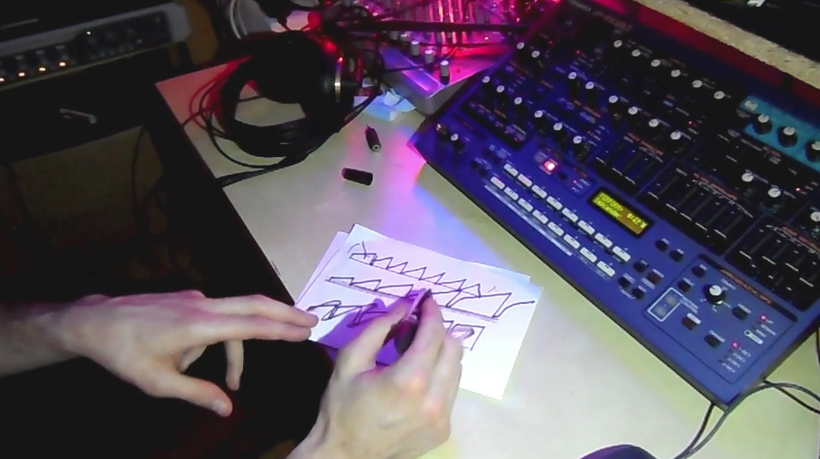don't blow it in the vector (Richard Sides, 2014) (Patreon)
Content

BY REQUEST: Nicki Duval
If I had been seduced, or even intrigued, by the music under consideration in this lo-fi doc, I might've been able to overlook its formal and technical shortcomings. But the acts profiled -- Theo Burt, Mark Fell, Lorenzo Senni, and EVOL -- fall between chairs for me. To hear them talk, they mostly seem to be looking for ways to jump off from more conventional EDM, attempting something more abstract. But watching them at work, for me, only clarified just how little interest I have in their project.
For the most part, they start with beats, and then subject them to algebraic functions that compress or expand their tempo, disrupt the loop, or otherwise introduce irregularity into what remains, really, a fairly regular sound pattern. In the diagram above, one musician (Senni, I think -- Sides doesn't bother labeling anyone) explains that EDM is typically about sonic stimulation before dropping the beat, and he actually compares this to sex. (He is assuming both regular beats and heterosexual vanilla sex, it seems.) He, however, is interested in delaying the orgasmic payoff, putting the listener in a kind of suspended state of excitation.

So, a few things about this. First, there is a whole ethno-musicological history of associating rhythm with sexuality, and it's pretty problematic. That's because these beats have been called "tribal," "African," or whatever -- in other words, the creation of Black people, who are allegedly more sexual, more embodied, etc. It's primitivism, and it's gross. But even on a formal level, the music these guys are producing doesn't differ that much from EDM, or criticize it in any way. It's just boring EDM. One of the artists keeps making a point of saying he and his peers don't have academic backgrounds. This is framed as a kind of rejection of elitism.
But having an academic knowledge of composition, or even just a curiosity about more complex electronic music, would offer these guys different tools. The tools they all seem to have are based in computer science and programming, which yields rather limited results. Theo Burt, perhaps the most interesting artist in the film, uses graphic design and interlocking shapes to produce tone clusters, so there's a correspondence between visual and sonic information. But as we see, once he establishes this, all he can really do is speed it up or slow it down.

Sides' film, as a film, is not especially adept at either illuminating the artists' practice or offering some sort of visual counterpoint to the music itself. It's clear Side is trying, as when a piece of music apparently generated with randomly generated points on a plane, is juxtaposed with an extended shot of an empty field. In one interstitial segment, we see someone emphasize their anti-academic credibility by literally burning a copy of Michel Chion's Audio Vision. This poses the question, when is a metaphor not a metaphor?
I must say, I feel like I have been seeing a lot of examples of DIY filmmaking recently, and a lot of it exhibits the shallowness of fan culture, combined with a very web-driven attempt to assert mastery over an aesthetic discourse (music, avant-garde film, political theory) while adamantly rejecting any conventional book learning. It's very dudish, and speaks to our current moment: "I do my own research." I fear we are watching the Letterboxd-ification of art. How did I get so old?
You can watch don't blow it in the vector right here.
